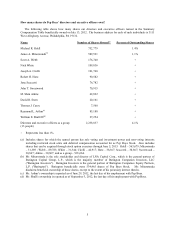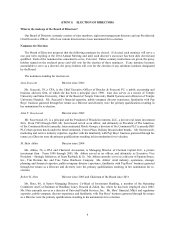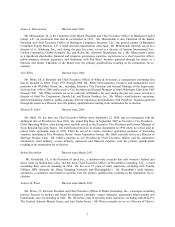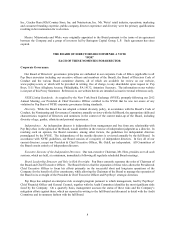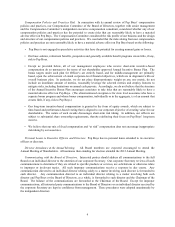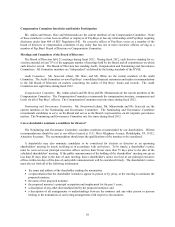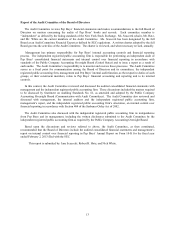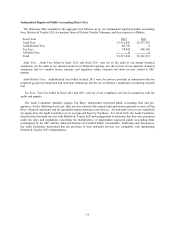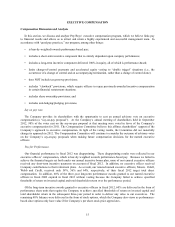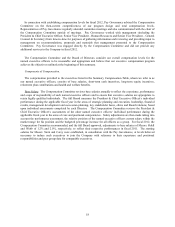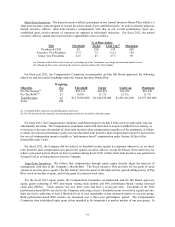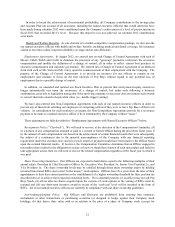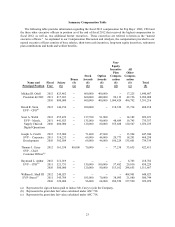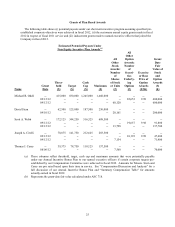Pep Boys 2012 Annual Report Download - page 19
Download and view the complete annual report
Please find page 19 of the 2012 Pep Boys annual report below. You can navigate through the pages in the report by either clicking on the pages listed below, or by using the keyword search tool below to find specific information within the annual report.15
EXECUTIVE COMPENSATION
Compensation Discussion and Analysis
In this section, we discuss and analyze Pep Boys’ executive compensation program, which we believe links pay
to financial results and allows us to attract and retain a highly experienced and successful management team. In
accordance with “good pay practices,” our program, among other things:
•is heavily weighted towards performance-based pay;
•includes a short-term incentive component that is entirely dependent upon company performance;
•includes a long-term incentive component delivered 100% in equity, all of which is performance-based;
•limits change-of-control payments and accelerated equity vesting to “double trigger” situations (i.e., the
occurrence of a change of control and an accompanying termination, rather than a change of control alone);
•does NOT include tax gross-up provisions;
•includes “clawback” provisions, which require officers to repay previously-awarded incentive compensation
in certain financial restatement situations;
•includes share ownership provisions; and
•includes anti-hedging/pledging provisions.
Say on pay vote.
The Company provides its shareholders with the opportunity to cast an annual advisory vote on executive
compensation (a “say-on-pay proposal”). At the Company’ s annual meeting of shareholders held in September
2012, 98% of the votes cast on the say-on-pay proposal at that meeting were voted in favor of the Company’ s
executive compensation for 2011. The Compensation Committee believes this affirms shareholders’ support of the
Company’ s approach to executive compensation. In light of the voting results, the Committee did not materially
change its approach in 2012. The Compensation Committee will continue to consider the outcome of advisory votes
on the Company’ s say-on-pay proposals when making future compensation decisions for the named executive
officers.
Pay for Performance.
Our financial performance in fiscal 2012was disappointing. These disappointing results were reflected in our
executive officers’ compensation, which is heavily weighted towards performance-based pay. Because we failed to
achieve the financial targets set forth under our annual incentive bonus plan, none of our tenured executive officers
received any short-term incentive payments on account of fiscal 2012. In addition, no executive officer received
Company contributions to their retirement plans. As a result,our tenured named executive officers, Messrs. Odell,
Webb and Cirelli, received only 58%, 56% and 64%, respectively, of their fiscal 2012 target total direct
compensation. In addition, 60% of the three-year long-term performance awards granted to our named executive
officers in fiscal 2009 expired in fiscal 2012 without vesting because the Company failed to achieve specified
thresholds of return on invested capital and total shareholder return over the performance period.
Of the long-term incentive awards granted to executive officers in fiscal 2012, 60% are delivered in the form of
performance share units that require the Company to achieve specified thresholds of return on invested capital and
total shareholder return in the subsequent three-year period in order to deliver any value to our executives. The
remaining 40% balance were delivered in the form of stock options, which the Company also views as performance-
based since options only have value if the Company’ s per share stock price appreciates.


